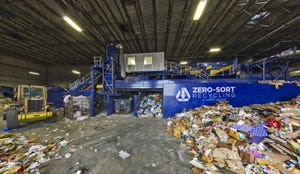Some Assembly REQUIRED
Streamlining the spec'ing process to put together more affordable trucks.
Two Years Ago, Houston-based Waste Management made a major course change when it came to buying new equipment for its fleet: it decided to get out of the truck engineering business.
That's not to say the company eschews feedback from drivers, maintenance technicians and fleet managers when it specs its trucks, nor does the company ignore the chance to incorporate new technology and redesigned components into its refuse equipment. What “getting out of the engineering business” really means, says John Lemmons, the company's fleet and performance director, is that Waste Management no longer seeks to create a “customized truck” — a vehicle painstakingly designed to an ideal internal to Waste Management's fleet alone.
“Once we take into account spec changes that lower maintenance costs, for example, or improve driver ergonomics, then we turn the vehicle over to the OEM for the rest — to build us an industry-standard truck that will meet our performance parameters,” Lemmons says.
“The idea is not to go spec-by-spec and create a truck customized to our operation alone,” he notes. “That adds cost to the vehicle. What we want is a truck based on industry-wide specs, one we can use border-to-border and coast-to-coast, a truck robust enough to handle Minnesota winters and Arizona summers.”
Lemmons says Waste Management strove to cut individual specifications for its refuse trucks from 720 down to 40, with 1,000 options pared down to fewer than 100, in an effort to create a “standard” spec sheet for its vehicles. While the company continues to use a variety of truck types in its fleet — including rear loaders for residential service, roll-offs for dumpsters and front loaders for commercial accounts, to name a few — Lemmons stresses that the key is establishing a standard set of specifications within each of those groups. “We want a uniform truck, like UPS and FedEx, that helps reduce our maintenance costs and vehicle downtime,” he says. “More uniformity within the fleet streamlines our ability to take care of the equipment.”
Work in Progress
Jerry Wickett, vice president of purchasing and maintenance for Fort Lauderdale, Fla.-based Republic Services, explains that one of the keys to refuse truck spec'ing is to adjust specs on an ongoing basis, rather than once a year.
“We view spec'ing as a continual work-in-progress,” he says. “Our computerized maintenance system gives us all the detail we could want about how specific components perform over time in the field. If a new component — say an axle — is introduced, or a new long-life fluid, coolant, or engine oil, we can put that into one of our trucks and track its performance against the rest of the fleet, validating the benefits we're supposed to get.”
Republic operates 5,000 trucks in 21 states, which are divided up into five regions. Work load and conditions vary tremendously for the company's vehicles. Some vehicles service as few as 10 routes, while others as many as 300. Nevertheless, the company aims to create a single “standard” spec sheet for its vehicles to help lower the cost of operations.
“We actually have two [standard spec sheets] — one for California and one for the rest of the states we serve,” Wickett says. “Sticking to a standard set of specs keeps your costs down in terms of the cost to build the vehicles, and standardization is something we aim to achieve across the company, from our maintenance practices into other operating disciplines.”
Many of the spec'ing choices Republic makes represent an effort to minimize costs over the life of the vehicle. For example, the company went to 8-inch brake pads for all of its trucks to lengthen brake shoe service intervals, thereby saving on maintenance. Republic also now specs Allison automatic transmissions across its vehicle lineup.
Though more expensive compared to manuals, the automatics are easier for drivers of all skill levels to use and allow maintenance personnel to focus on caring for just one type of transmission instead of two, Wickett adds.
“It's the sign of the times,” he says. “We used to give our most senior drivers manual transmissions, but from a productivity standpoint, it just made more sense to stick with one type.”
Reducing Costs
The reason spec'ing choices are so critical for today's refuse operators boils down to one word: cost.
Darry Stuart, president of Boston-based DWS Fleet Management, which specializes in fleet maintenance issues, stresses that standardizing to the right component spec will save a refuse fleet money, both from maintenance savings up front and long-term savings related to the life cycle of the vehicle.
“You will spend money on maintenance, that's a given,” says Stuart, who spent five years of his 35-year career as a fleet manager working for BFI prior to its purchase by Phoenix-based Allied Waste Industries. “The focus for the refuse fleet manager is where [to spend] and where not to spend that maintenance money. Because you can go broke by over-maintaining your equipment, you have to determine the key areas on the vehicle you need to maintain.”
Several key component areas must be watched on refuse trucks, he says, starting with brakes, then tires, axles, air and fluid filtration systems, the cooling system, batteries, transmission linkages, and all chassis and body fasteners.
“In the trash business, you have higher brake and tire wear from the heavy stop-and-go operating requirements of most industrial and residential refuse collection vehicles,” Stuart says. “Spec'ing the right pads and tires will help lower your costs in those two areas. Making sure you use the right tires — ones designed with stiff sidewalls, to absorb the impact of scuffing against curbs — adds some longevity there, as well as preventing downtime from flats due to heavy wear.”
Republic Services considers several spec'ing factors that impact truck costs across the board, Wickett notes. “We look at specs from several angles: how do they impact truck productivity, how they lower our annual maintenance costs, and how they improve on vehicle durability,” he says. “One big factor is extended drains for a variety of lubricants, from hydraulic fluid to engine oils. They've become much more important in our spec'ing process over the last three to four years.”
Lemmons notes that extended engine oil drains also are a critical component of his spec'ing considerations. “We've gone from oil changes every 300 hours to every 600 hours,” he says. “Not only does that impact a variety of costs — from less vehicle downtime, to less maintenance and engine oil spend — it also reduces our waste stream in terms of used oil.”
In the end, Stuart says, the key is to buy the right truck for the right application, then set up a preventive maintenance (PM) program and stick to it. “To get a truck to last for the long-term — whether your ownership expectancy is eight years, 10 years, or 15 years — treat the truck the same every day and manage its needs from PM interval to PM interval,” he says. “To do that, you need to spec the right components on that truck so it can handle the job, while minimizing the amount of maintenance dollars you spend on it to keep it running.”
Sean Kilcarr is a senior editor for Fleet Owner, a sister publication of Waste Age.
About the Author
You May Also Like


